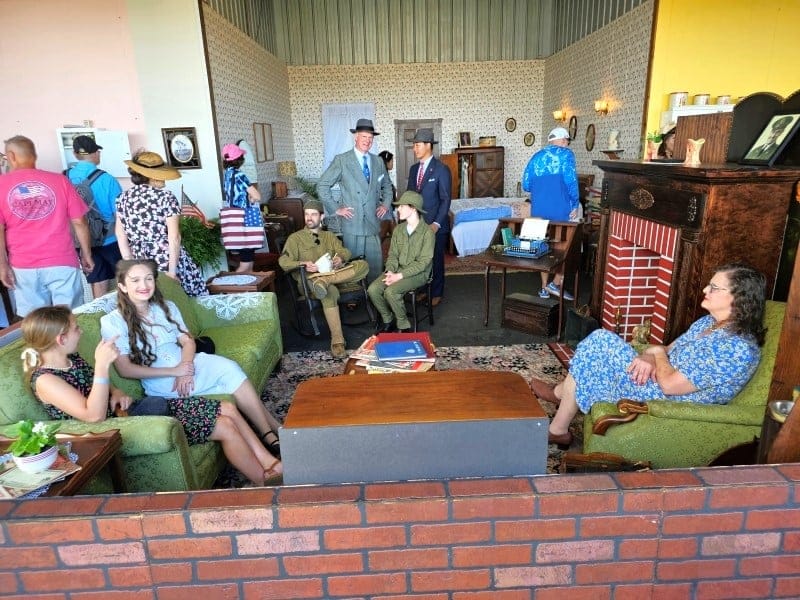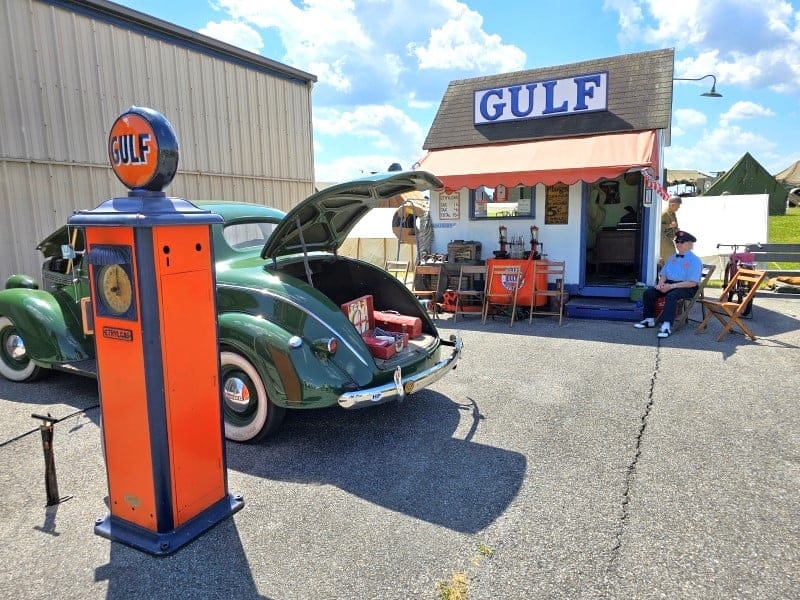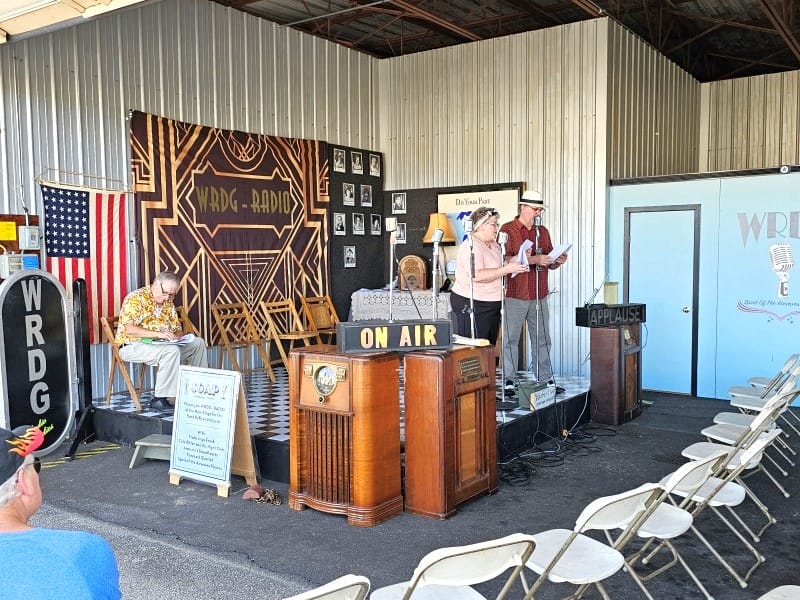Once again, we were immersed in 1944 as we entered the WWII Weekend in Reading, Pennsylvania, which took place on June 7, 8, and 9th, 2024.
There were over 1,500 WWII reenactors at the event, along with 80 WWII aircraft, over 200 military vehicles, and two big bands. The entire show encompassed more than 20 acres. To say it was gigantic is an understatement.
Total Immersion
Upon entering the event, which is held on the grounds of the Reading, PA Airport, guests are fully engulfed and immersed in the 1940s. Big band music is being played everywhere. Thousands of people walk around in period clothing, even people who are not officially reenactors; many attendees dress up as well. This, in addition to a couple thousand reenactors, really is a sight to see.
In fact, at the flea market, which is gigantic, there are vendors who sell period clothing. Whether you’re looking to add a piece or two to your 1940s ensemble or acquire an entire outfit, there will be something there for you. Vendors also sell uniforms and all manner of militaria, including weapons and other gear in the flea market. And it’s not just WWII items; it’s from every time period imaginable.
Reenactors walk among the crowds throughout the entire show and are more than happy to pose for photos with attendees. If you’ve ever wondered about details of their uniforms or gear, just ask them. They will gladly launch into a tutorial on whatever you’d like to know. I’ve found them to be gracious when dealing with all types of questions and have a thirst for educating people.

It’s completely normal to see the crowd part, and a jeep with a Browning .50 cal., loaded with soldiers, drives through. Or a German motorcycle with a sidecar, complete with MG-34 mounted on the sidecar, will drive past. Static displays are very cool, but guests will get to see vehicles driving around with regularity, which is fantastic.
Most of the time, they’ll even let people handle the weapons or sit in the vehicles, with one caveat: Ask before you touch! Don’t just grab something and pick it up; that ticks people off. As long as you ask, it will be granted to you about 99.9% of the time. You’ll get to handle belt-fed machine guns, submachine guns such as the .45 ACP Thompson or 9mm German MP-40, rifles, grenade launchers, anti-tank weapons, and pretty much anything else that was in WWII. They even have artillery pieces sitting around.

The Civilian Side Of Things
As if the military aspect of the WWII Weekend wasn’t enough, a sizeable area is set aside to portray the Home Front and what it was like to be a civilian during the war.

One building is set up to resemble a house, with divided rooms such as the living room, kitchen, bedroom, and dining room. The carpets, furniture, and appliances are all 1940s period. Even the cupboards are stuffed with boxes and cans from the time period. The attention to detail (not only here but throughout the entire show) is impeccably obsessive; these folks have an intense drive to get the fine details correct. You’ll marvel at the wringer clothes washing machine and the ice box in the kitchen. The more you look around, the more small details that you’ll notice.
Nearby is a small “store” where you can buy old-time candy and other trinkets.

A service station is also set up, complete with a gas pump out front and period vehicles all around. All the accoutrements are accurate, including the cans of oil and other service station items.
One very interesting stop was at the Victory Gardens stand, where a very sweet lady explained to us how fat, grease, and oil were collected and used around the house during the war years. After the fat outlived its usefulness at home, it was dropped off at the local butcher shop, where it was then collected for use in munitions plants. First, they boiled it to make soap, during which process the glycerin was extracted. The glycerin was then turned into nitroglycerin, used in making gun powder and explosives for the war effort. The time it took from when the fats left a kitchen until it was made into nitroglycerin was about three weeks, which is surprisingly fast.

The kind lady also explained how seemingly insignificant things, such as cloth for clothing, were rationed. Skirts were limited in the circumference that they could be, and some pockets had to be omitted from civilian clothing to save cloth to make uniforms. As well, baggy styles of clothing were banned to stop the waste of excess fabric.

There’s also a movie theater nearby. Next to that is a stage where entertainers put on simulated radio shows, with singing and comedy dialogue. There are seats so an audience can take a break from the weather. Speaking of weather, Pennsylvania has two types of weather for this weekend, and this rarely varies: Sweltering hot with high humidity or rainy with temperatures in the 60s. There seems to be no happy medium with Mother Nature for the first weekend in June. She’ll either leave you flame-broiled or shivering and soaking wet. This year we were blessed with rare, perfect weather in the mid to upper 70’s, with a little cloud cover to give us an occasional reprieve from the sun. Better weather could not have been expected.

Maybe it’s just me getting old, but I now find this Home Front/Civilian section of the show to be just about as entertaining as the military aspect of it.
Special Guests
In past years, we met many very special guests at the WWII Weekend. One year, General Paul Tibbetts was there. And for a number of years, “Dutch” Van Kirk, the navigator for the Enola Gay, would attend. Several of the actual Easy Company vets from the Band of Brothers series were also there, including Bill Guarnere, Don Malarkey, Buck Compton, Forrest Guth, Babe Heffron, and Shifty Powers. Dick Winters even stopped by once, and we missed meeting him by about ten minutes, much to our chagrin.
Col. Robert Morgan, the pilot of the Memphis Belle, attended the show regularly for years, and I had the pleasure of corresponding with him and becoming friends. Opportunities to become friends with heroes such as these do not present themselves very often. I had also become friends with Forrest Guth from Easy Company and found him to be one of the nicest guys I’ve ever met. We corresponded often until his passing. In fact, they all were wonderful men who were very friendly and engaging.
My daughter expressed sadness that these great heroes are mostly gone, but she also mentioned that they made the show more exciting and enjoyable. I’m so happy that I had the chance to introduce her to these legends because I can now see how they shaped her love of history. It’s one of the greatest gifts that we can give our children.
As with all others, this year’s show features several World War II veterans, of whom I’ll mention a few here.
- Sgt. Andrew Valero was at the Battle of the Bulge, Ardennes Forest, Hurtgen Forest, Remagen, and security at the Dachau Concentration Camp (post-war).
- Lt. Commander (US Navy) Leo Dorman flew 37 different aircraft throughout WWII, Korea, and Vietnam.
- Coxswain Edward Conrad was a Seabea on Iwo Jima and Okinawa, shooting down Kamikaze planes.
- PFC Walter LaSota received two purple hearts and was on Okinawa.
- TSgt. Quentin Stambaugh was a B25 Radioman and Tail Gunner, surviving 38 combat missions and 27 non-combat missions in the Pacific Theater.
- 1st Lt. Ray Firmani was a B-17 pilot who flew 25 missions over Europe.
- Coxswain Edward Czechowski received a silver star for shooting down a Kamikaze with a 20mm canon before it could hit his destroyer.
- Dorothy Trate, “Rosie The Riveter”, manufactured parts for aircraft and other weapons on the home front.
These are just a few special guests; several more were in attendance. It’s always a treat to talk with people who were really there.
Aircraft
Attendees can book rides in various aircraft, including a P51 Mustang, a Douglas SBD-5 Dauntless, a B-25 named “Panchito,” a B-29 named “FiFi,” and a few others.

Or, if you don’t want to go up in the air, you can simply peruse the rows of dozens upon dozens of aircraft and watch many of them flying above the airfield as part of the show. There were several fighter aircraft, as well as several bombers present.

The fighters include a Corsair, a KingCobra, a couple of Mustangs, a Zero replica, and a Warhawk. Various fighter planes were doing high speed passes just above the ground, which was exciting to watch.

Some displays were set up to allow visitors a hands-on aspect to aircraft. Specifically, the nose portion of a B-25 was present and anyone could walk up and check it out.

The top turret from a B-17 bomber was on hand, and it was powered up so visitors could actually get in and spin it around, raising and lowering the guns. These treats were welcomed by both children and adults.

Vehicles
The volume of vehicles present is staggering. There are jeeps and similarly sized vehicles of every description. One year I even saw a German “Goliath”, which is a small, remote controlled tracked vehicle used to deliver explosives. It was small, almost two feet tall, and about five feet long, and seeing it operating was a real treat.

There are German and American tanks, including Shermans, a Stuart, Panzer III and IV, as well as many others. It’s not unusual to see a Bren Gun Carrier and other armored vehicles. Motorcycles with sidecars, armored cars, and half-tracks (both American and German) are plentiful.

I climbed into an M3 Stuart light tank and discovered that the quarters were rather cramped.

If you love armor, you’re going to be very happy here.
Encampments
A French village is set up there, and American and German forces occasionally engage in firefights to battle over the village. Watching machine gunners rip through some belts of blanks, supported by riflemen, is an enjoyable afternoon.

Aside from that, there are encampments portraying American, French, Japanese, and other WWII combatants all around the show. They camp there for the entire weekend. All around these camps, there is gear and weapons set up that visitors can check out and learn about.
Demonstrations
Reenactors performed many demonstrations throughout the WWII Weekend in Reading, PA. One such demonstration really caught my eye: the flamethrower demonstration hosted by the Marine contingent at the show. The Marines performed a simulated assault on a Japanese position in the Pacific on Iwo Jima, complete with flag raising at the end.
This year, the Marines were using four flamethrowers for the assault! It promised to be a spectacular show, and it did not disappoint!

Before the demonstration, I caught up to the detachment’s OIC (Officer In Charge) and asked him a few questions about flamethrowers. I’d seen them in action before, and despite being well over 50 yards away, I could still feel considerable heat coming from them. I asked him how it felt being the gunner of the weapon and how the gunner managed to weather such heat.
He explained that a suction effect is created when the weapon is fired, and that suction brings in cooler, fresh air from behind the gunner, which takes away a lot of the heat. He also mentioned that it’s important to not fire the weapon into the wind but rather with the wind. Further, he noted that anyone standing to the sides of the gunner is in for a significant blast of heat. I believe him!
During this exhibition, all four flamethrowers were in use at once, and the spectacle was nearly indescribable. Flames and black smoke poured forth, much to the crowd’s delight. It’s extremely rare to see anything this special these days, and we felt privileged to be there watching.
Final Thoughts
All in all, 2024 was a sparkling year for Reading PA’s World War II Weekend. The special guests, veterans, aircraft, vehicles, demonstrations, and perfect weather all combined to make it a memorable experience. My daughter and I can’t wait for next year, as we won’t miss it for the world!
The dedication of the organizers and support staff, as well as the enthusiasm of the reenactors, cannot be overstated. They go the extra mile to make the show spectacular. The reenactors are friendly and eager to share their vast knowledge with guests, which makes everyone feel welcome.
Another aspect that puts this show above all others is the sheer volume of World War II equipment present. Nowhere else can you see tanks, planes, artillery, small arms, and reenactors from so many various countries represented. Literally, every country that was in WWII was represented at the show, which is unparalleled.
If you’re a WWII buff, you really owe it to yourself to attend the World War II Weekend in Reading, Pennsylvania. You’ll thank me later.


